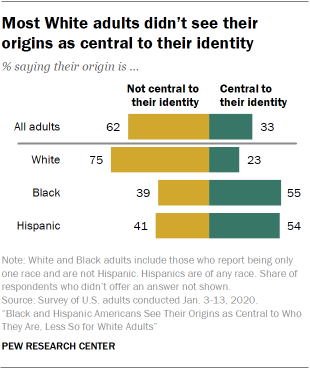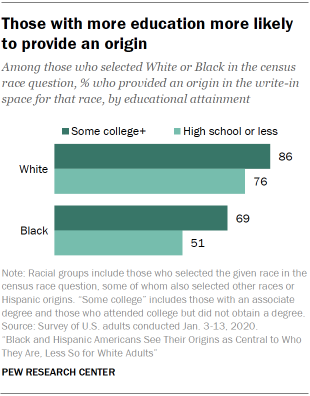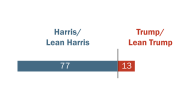Many Americans are familiar with their ethnic origins, but the extent to which they feel a connection to these roots varies widely by race and ethnicity. Black and Hispanic adults were more likely than White adults to see their origin as central to their identity and to feel connected to their family’s cultural origin.
When survey respondents were asked to specify their origins in questions identical to the ones that appeared on the 2020 decennial census about their race and ethnicity, a large majority did so. Most of those who selected White as their race gave a European nationality, and most who selected Black wrote in African American.
Black and Hispanic adults see their origins as more central to their identity and feel more connected to their roots than White adults
A majority of Americans across racial and ethnic groups said they were very familiar with their origins. Hispanics were the most likely to say this, compared with smaller shares of non-Hispanic, single-race Black and White adults.
Consistently across racial and ethnic groups, older adults were more likely to report being very familiar with their origins. About two-thirds of all adults 50 and older (65%) did so, compared with 55% of those younger than 50. Those with at least some college education were also more likely than those who did not attend college to be familiar with their family’s roots (62% vs. 56%).
Just under half of U.S. adults (46%) said they felt a strong connection with their family’s cultural origin, and a smaller share (33%) said their origin was central to their identity. Reflecting previous research, Black and Hispanic adults were much more likely than White adults to say they felt a strong connection and to see their origins as central to their identity. Foreign-born Hispanics were particularly likely to say they felt their origins were important in these ways.
The findings from these questions were closely intertwined – those who are familiar with their origins were far more likely to feel strong connections to their roots and to see their origins as central to their identity, and vice versa.
Most survey respondents provide an origin when asked
The two-step race and ethnicity questions used in the 2020 census asked respondents to write their origins in a provided write-in response area if they said their race was White, Black or African American, American Indian or Alaska Native, Other Asian, Other Pacific Islander or “some other race,” or if they said they had a Hispanic origin other than the ones provided.2 They also included check boxes for specific Asian, Pacific Islander, and Hispanic origins, such as Chinese, Native Hawaiian and Mexican. In the 2020 Pew Research Center survey, respondents were shown the same questions that appeared on the 2020 census form and asked for their origins, with the same examples provided on the census form.
In all, 88% of survey respondents provided an origin on the census questions – either by selecting a check box for an origin such as Korean or Puerto Rican in the race or ethnicity questions, or by selecting a race such as White or Black and specifying a valid origin in the write-in box.
The survey found that most of those who checked White or Black in the race question did provide an origin. Among those who selected White (regardless of whether they also selected any other races or said they were Hispanic), most (82%) provided at least one geographic origin such as German, Irish or European.3 A small share (4%) restated their race as their origin (“White”) and 14% either left the write-in space blank or provided an answer that was not related to their race or origin.4
Meanwhile, among those who said they were Black in the census question (again, regardless of any other races or ethnicities selected), 61% provided an origin such as African American or a country of origin. About a quarter restated their race (“Black”), and 15% did not give a relevant answer or left the write-in response area blank.
Among the 7% of respondents who checked “some other race,” 78% provided an origin, 1% stated a race and 22% gave an irrelevant answer or no answer at all.
Higher levels of education and being more familiar with one’s origins were associated with being more likely to provide an origin. Among those who checked White and those who checked Black in the race question, adults with more education were more likely to have provided an origin. For the White write-in space, 86% of those with at least some college experience provided an origin, compared with 76% of those with a high school diploma or less education. Meanwhile, in the Black write-in space, 69% of respondents with some college education or more provided an origin, vs. 51% of those who did not attend college. In both write-in spaces, those with lower levels of education were more likely to restate their race (“White” or “Black”) as their origin than those with more education. (The sample size for those who checked “some other race” is too small to analyze subgroups.)
Whether or not people provide an origin seems to be more related to their knowledge about their family’s origins than to how attached they feel to these origins. While those who said they were familiar with their origins were more likely to provide an answer, those who said their origins were central to their identity were no more likely to do so than those who said their origins weren’t central.
Leading origins were European for those who selected White in the race question and African American for those who selected Black
Among adults who reported that they were White (some of whom were multiracial or Hispanic) and provided a geographic origin, European origins such as English, German or Scandinavian were the most common by far, with 84% offering this type of response. An additional 17% gave an origin from the Americas, such as “American” or Canadian, and 1% gave a Middle Eastern or North African origin. (Respondents could offer more than one answer, so the total adds to more than 100%.)
Among those who selected Black on the census question (on its own or in addition to another race or Hispanic origin), 83% said their origin was African American. Smaller shares said their origins lay in the Americas (9%), Sub-Saharan Africa (8%), the Middle East or North Africa, or Asia (1% each).
Many of those who selected “some other race” in the census race question may have done so because they consider their Hispanic identity to be their race, while the census treats this as a separate question. In fact, 80% of those who selected “some other race” also indicated that they were Hispanic in the census question about Hispanic ethnicity. Nearly all the respondents of “some other race” who provided an origin said their origin was in the Americas (96%), while 5% said Europe and 1% said the Middle East or North Africa.5
Among those who did provide an origin, 21% provided more than one origin group for the White write-in space. By comparison, just 2% provided more than one origin in the Black write-in space and 8% did so in the write-in space for “some other race.”











